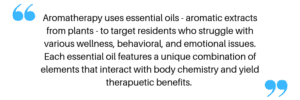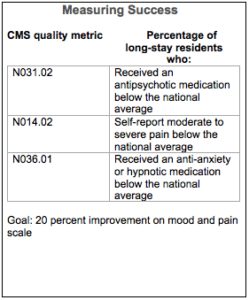Many senior living communities are looking for ways to decrease the use of antipsychotic medications through nonpharma approaches. The Centers for Medicare and Medicaid Services (CMS) has set a national goal of reducing the use of antipsychotic medication in long-term care facilities by 15 percent by the end of 2019.
A viable alternative? Aromatherapy. CMS supports the use of aromatherapy as an “individualized, nonpharmacological intervention to help meet behavioral health needs.” Clinical studies point to promising results: aromatherapy programs have helped in reducing medications for pain, anxiety, and depression, as well as improving sleep and lowering fall rates.
Improve your residents’ quality of life and health outcomes. Download our free webinar replay!
Taking the Nonpharma Path
Texas-based Lifetime Wellness, an innovator in implementing aromatherapy programs, is helping senior living providers to meet the CMS goal while following person-centered practices in senior care.
“Aromatherapy uses essential oils – aromatic extracts from plants – to target residents who struggle with various wellness, behavioral, and emotional issues,” says Callie Whitwell, chief operating officer and founding partner at Lifetime Wellness. “Each essential oil features a unique combination of elements that interact with body chemistry and yield therapeutic benefits.”
Lifetime Wellness laid the groundwork for its aromatherapy program for designated senior living communities in August 2018 and took it “live” in March 2019. The program targets residents with mood disorders, pain management, and/or Alzheimer’s disease or related dementia. Funding was provided through the state Civil Money Penalty Reinvestment Project (CMPRP) in support of key CMPRP goals: reducing adverse events, improving dementia care, and enhancing resident quality of life.

Tracking Results
As part of the CMPRP-funded program, Lifetime Wellness is teaming with several senior living providers on a pioneering initiative. Together, they are tracking the effectiveness of nonpharma interventions in residents who have reported moderate to severe pain, symptoms of depression, or are receiving anti-anxiety or antipsychotic medications. The program includes 10 percent of residents in 15 senior living facilities, along with interdisciplinary care teams, from clinical nursing to social services staff.
 “Our goal is to see how we can use aromatherapy benefits to reduce or manage resident stress, outcomes, such as changes in mood and level of pain, to track trends, report them back pain, anxiety, and depressive symptoms,” Whitwell says. “We’re monitoring to the state, and create broader applications for the future.”
“Our goal is to see how we can use aromatherapy benefits to reduce or manage resident stress, outcomes, such as changes in mood and level of pain, to track trends, report them back pain, anxiety, and depressive symptoms,” Whitwell says. “We’re monitoring to the state, and create broader applications for the future.”
Lifetime Wellness also offers the program to senior living communities outside the initial state grant program to bring aromatherapy benefits to all senior care residents. The company provides program supplies and resources, trains care and wellness staff in using essential oils safely, and offers guidance for documenting processes and measuring results. Also provided is an online store offering exclusive aromatherapy products not only for senior caregivers but for the wider community.
Testing the Blends
Key to the program’s success is using essential oil blends that are created with the elderly in mind. “While a lot of products are offered, we wanted to use the most beneficial blends for seniors, who often have frail skin,” Whitwell says. She works with a clinical aromatherapist to validate that the blends are safe and effective.
“Our topical roll-ons are prediluted so that senior care providers can be assured of safety when applying them to older adults. We use fractionated coconut oil to reduce any risk of severe skin reaction.” Lifetime Wellness also offers undiluted essential oil blends for use in an ultrasonic diffuser or fan diffuser.
“A lot of people today are experimenting with aromatherapy benefits and essential oils, but not from the perspective of clinical outcomes,” Whitworth says. “We hope that our program can serve as a model for the seniors we serve in Texas, and – with demonstrated success – expand quality, person-centered, nonpharma interventions nationwide.